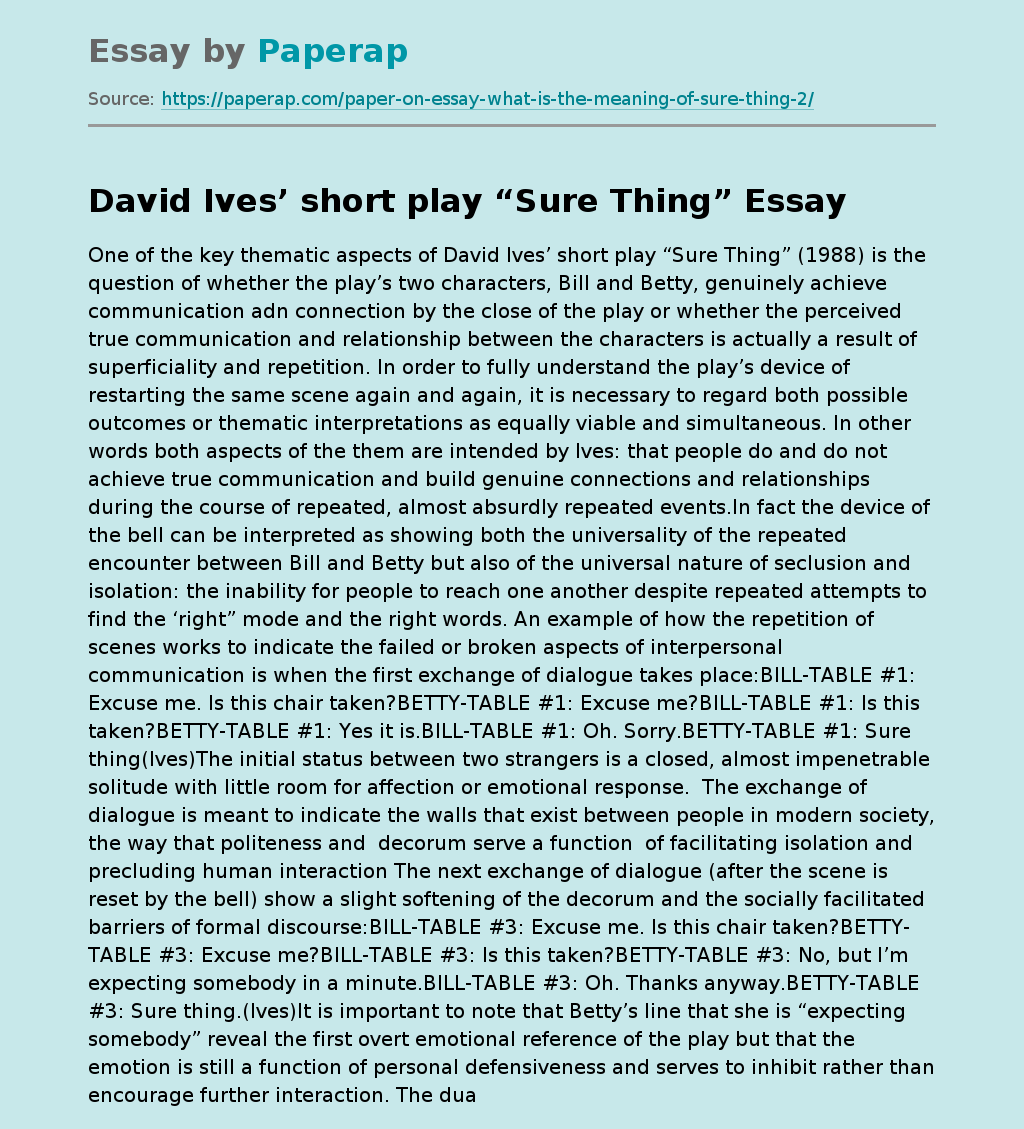David Ives’ short play “Sure Thing”
One of the key thematic aspects of David Ives’ short play “Sure Thing” (1988) is the question of whether the play’s two characters, Bill and Betty, genuinely achieve communication adn connection by the close of the play or whether the perceived true communication and relationship between the characters is actually a result of superficiality and repetition. In order to fully understand the play’s device of restarting the same scene again and again, it is necessary to regard both possible outcomes or thematic interpretations as equally viable and simultaneous.
In other words both aspects of the them are intended by Ives: that people do and do not achieve true communication and build genuine connections and relationships during the course of repeated, almost absurdly repeated events.In fact the device of the bell can be interpreted as showing both the universality of the repeated encounter between Bill and Betty but also of the universal nature of seclusion and isolation: the inability for people to reach one another despite repeated attempts to find the ‘right” mode and the right words.
An example of how the repetition of scenes works to indicate the failed or broken aspects of interpersonal communication is when the first exchange of dialogue takes place:BILL-TABLE #1: Excuse me. Is this chair taken?BETTY-TABLE #1: Excuse me?BILL-TABLE #1: Is this taken?BETTY-TABLE #1: Yes it is.BILL-TABLE #1: Oh. Sorry.BETTY-TABLE #1: Sure thing(Ives)The initial status between two strangers is a closed, almost impenetrable solitude with little room for affection or emotional response.
The exchange of dialogue is meant to indicate the walls that exist between people in modern society, the way that politeness and decorum serve a function of facilitating isolation and precluding human interaction The next exchange of dialogue (after the scene is reset by the bell) show a slight softening of the decorum and the socially facilitated barriers of formal discourse:BILL-TABLE #3: Excuse me. Is this chair taken?BETTY-TABLE #3: Excuse me?BILL-TABLE #3: Is this taken?BETTY-TABLE #3: No, but I’m expecting somebody in a minute.BILL-TABLE #3: Oh. Thanks anyway.BETTY-TABLE #3: Sure thing.(Ives)It is important to note that Betty’s line that she is “expecting somebody” reveal the first overt emotional reference of the play but that the emotion is still a function of personal defensiveness and serves to inhibit rather than encourage further interaction. The dual progression demonstrated by these two opening scenes: one a movement toward emotion and toward interpersonal communication, the other a simultaneous movement toward defensiveness and isolation exemplify the progression of dual themes that persist right through to the end of the play.By the time Bill and Betty have made a demonstrable connection — one that the audience can at least belive may be genuine, there is still no change in the outer formality of the dialogue and its simultaneously evasive and self-protective function. More than learning to truly reach one another or truly communicate, the characters can be understood to have reached a mutual understand of permissable superficiality. A sample of the closing dialogue shows that Ives intends the ambiguity of the perception of the charatcers’ true connection and emotional response to function, in fact, as a way of expressing two themes simultaneously which contradict one another but are nevertheless apparent throughout actual human society:BILL-TABLE #3: Y’know I was headed to the-BETTY-TABLE #3: (simultaneously) I was thinking about-BILL-TABLE #3: I’m sorry.BETTY-TABLE #3: No, go ahead.BILL-TABLE #3: I was going to say that I was headed to the movies in a little while, and…BETTY-TABLE #3: So was I.(Ives)In conclusion, Ives intended “Sure Thing” to express a dual theme: that human both incapable of reaching a state of true connection and communication but they are equally incapable of escaping the constant drive to seek just such a connection and relationship. In this way, the device of scene-repetition in the play is able to express to seemingly contradictory themes simultaneously in order to more fully represent the actual state of human relationships in the modern world.
David Ives’ short play “Sure Thing”. (2019, Dec 05). Retrieved from https://paperap.com/paper-on-essay-what-is-the-meaning-of-sure-thing-2/

